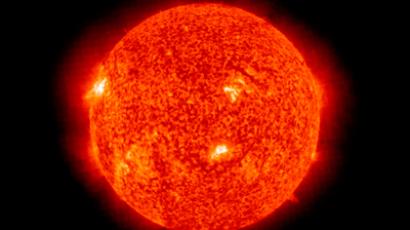Solar storm strikes Earth following monster flare (VIDEO)
A large coronal mass ejection has reached Earth – days after the Sun sent a massive burst of solar wind and electromagnetic radiation towards our planet. While causing no major geomagnetic storm, it has produced spectacular auroras in northern Europe.
The coronal mass ejection (CME) arrived near Earth at 2:32pm EST
(7:32pm GMT) on Thursday, with its effects expected to continue
throughout Friday, according to US National Oceanic and
Atmospheric Administration (NOAA).
NOAA’s Space Weather Prediction Center has issued a warning of a
geomagnetic storm with “minor disruptions to communications
and GPS.”
While the world’s economies braced for possible blackouts in
high-frequency airline and military communications, disruptions
to GPS signals and power grids, enthusiasts in the northern
hemisphere rushed outdoors in the hope of viewing the stunning
aurora borealis as far south as Colorado.
However, American aurora spotters have been disappointed, as,
according to spaceweather.com, the CME’s impact was “weaker
than expected” and failed to produce widespread storms. Some
frustrated Twitter users also blamed cloudy skies for not being
able to see the northern lights.
Wow RT @EdPiotrowski: Harald Albrigsten captures the #aurora in all its glory tonight in Kvaløya, Norway. pic.twitter.com/BMlfgm2Yap
— Maninder Dhaliwal (@dhaliwalmk) January 10, 2014
Observers were luckier around the Arctic Circle in Norway, where a dark and clear night at the time of impact, as well as more favorable latitude, put an aurora on display.
NOAA forecasters still estimated an 85 percent chance of polar
geomagnetic storms before the end of Friday, and media cheered
the sky watchers by saying there remains a chance of some clear
aurora sightings Friday night.
The CME that stroke the Earth has been associated with the large
X1.2-class solar flare that was unleashed from a giant sunspot
AR1944 on January 7. The flare has been described as the most
powerful this year so far, with X-class denoting the most severe
intensity.
The solar phenomenon, which can send billions of tons of particles from the Sun’s atmosphere into space, is luckily not directly harmful for humans, as the Earth’s atmosphere prevents the particles from coming through. However, solar storms can affect electronic systems in satellites and on the ground, causing varying levels of disruption, and can potentially pose some danger to the astronauts orbiting the planet on board the International Space Station (ISS).
While NASA downplayed the possible impact of the current CME,
saying it did not represent a threat to the ISS, the space
weather concerns sparked a day-long delay of the Orbital Sciences
Corp. Antares rocket launch. The rocket successfully blasted in
to space on Thursday, carrying the commercial cargo ship Cygnus
with supplies for the ISS crew.
Scientists are expecting more solar flares to erupt, as the Sun
is currently in an active phase of its 11-year solar weather
cycle. The current one, known as Solar Cycle 24, started in 2008.















